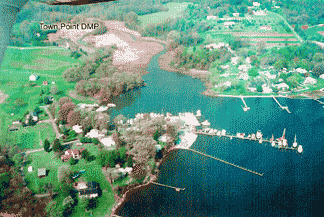|
|
 |
||||||||||
|
|||||||||||
|
|||||||||||
Dredge Spoils Plan Deep-SixedAnne Arundel Exec Leopold dumps two decades of planning and over $1.5 million to “save the communities.”by Sandra Olivetti MartinWanted: to lease or buy, dredge spoils dump site, to receive silt from Anne Arundel County creeks. Waterfront preferred. Terms generous. Anne Arundel County is in the market for a new dredge spoils site. Even better, a miracle that will make the spoils a hot commodity. “We need additional sites placed where appropriate and … to continue the ongoing search for technologies to use spoils in positive and productive ways,” County Executive John Leopold told Bay Weekly after he swept away 21 years of county planning and an investment of over a million dollars. With his grand sweep, Leopold left a big hole on one side. On the other side, Leopold spread joy and set a county-wide precedent by promising to “preserve the rural character and ecological health of your communities.” “That’s how county government should work,” said Paul Rensted, the elated receiver of Leopold’s two-page commitment and the point man on the team that had negotiated — Rensted prefers the word mediated — his corner of Southern Anne Arundel County out of harm’s way. Trouble on a Scenic BywayThe trouble blew up over Anne Arundel County’s plan to dredge silt from the many creeks — too small for commercial navigation — that indent our long, dog-toothed shoreline (Anne Arundel’s Bottomless Pit: Vol. 15, No. 7: February 15). Over the years, as silt accumulated, dredging plans were laid and money for the work ebbed and flowed, Anne Arundel County made long-term investments in six silt depositories. In 1986, it leased a site in the backwaters of Rockhold Creek at Town Point to assure county silt a long future of safe deposit. Starting with southerly Broadneck and Carrs creeks in 2007, the site would fill up with the dredged silt trucked in from three to six waterways a year. Deposits would dry for a year, then be trucked eight miles to Sudley Landfill. The next year, more silt from new creeks would come in, all the way to 2022. It was, on the drawing boards of county planners and consultants, a perfect plan. For the communities near ground zero, however, the perfect plan was the perfect storm. Industrial-scale intrusion would pollute the waters and trample critical areas, citizens argued in a swell of protest. An annual round-trip procession of 3,500 heavy trucks would command winding, rural roads, many of them designated as Maryland’s Roots and Tides Scenic Byway. A dredge spoils site as a neighbor would spoil the life of the quiet communities of the Fairhaven region at the county’s southern end. Shared InterestsThat’s in brief the argument that scuttled the county’s well-laid plan. The organizing force of the citizen opposition was Herring Bay Advocates. In months of negotiation by Rensted and Kathy Gramp, both of Fairhaven, the Advocates moved the county away from the long-term, county-wide, truck-enabled portion of the plan toward small-scale, small-region, short-term containment. By May, (Redefining Homeland Security: Anne Arundel repels sprawl at four points on its borders: Vol. xv, No 19: May 10), County Councilman Ed Reilly had both written trucking out of this year’s county budget and vowed to keep it out of all future budgets. If trucking was out, what was in? That’s the issue Rensted and his Advocates mediated throughout spring and early summer. The long-promised dredging of Southern Anne Arundel neighbors on Broadwater and Carrs creek needed to be in. County planners, too, needed to salvage something from their long-term investment at Town Point. “We had a shared interest,” said Rensted. “We just had to figure out how we all could be happy.” By late July, all were happy enough to bring in Leopold, to give, in his words, the “necessary assurance.” In the deal, citizens along the two creeks were happy. Their creeks, plus Town Point Cove, would be dredged in 2009. The money — $950,000 for Broadwater Creek and $740,000 for Carrs Creek, split between the state and the county — has already been budgeted. The state portion comes from Maryland’s Waterways Improvement Fund, supported by the excise tax on boats, and amounting nowadays to about $30 million a year. Annually, about a third of the fund is spent on dredging projects like Broadwater and Carrs creeks, according to Waterways Improvement director Bob Gaudette, at Maryland Department of Natural Resources. Herring Bay Advocates were satisfied. Leopold accepted their arguments, agreeing to “eliminate the need for removing material out of Town Point Dredge Material Placement Site.” He further committed the county to “limiting its use exclusively” for those projects, to be complete by 2011, and “not pursue further use.” As far as Town Point DMP, a mere 80,000 cubic yards of additional silt will fill the pit the county once hoped would be bottomless. Even the approved projects will likely have to be squeezed to fit into Town Point DMP’s 13 acres. An Expensive BusinessStoring dredge spoils is costly business. Hamilton Chaney, whose Herrington Harbour North Marina leases space in its own dredge site off Rt. 256 in Tracys Landing, estimates that the cost of dredging roughly doubles every decade. His past dealings with Anne Arundel County suggest his estimate is low. In 1993, Herrington Harbour charged Anne Arundel “the market price of $7 a cubic yard to store dredge spoils until dry, rebating $2.” At the millennium, market rate had risen to $15. Over 21 years, Anne Arundel invested half a million dollars in leasing the 13 acres of Town Point DMP from Ned Crandell, owner of nearby Town Point Marina, and 85 acres of surrounding land. In all those years, the county deposited only 5,000 cubic yards of dredge spoils into Town Point. That drop in the bucket was augmented by 3,000 from Crandell’s own marina and 25,000 more deposited by the Army Corps of Engineers after dredging Rockhold Creek, the channel into Deale as well as Herrington Harbour North and Crandell’s marina. Over the last two years, $860,000 more came from the fund for site engineering and construction. A long future of use would have lowered the storage cost per cubic yard, but not without new costs for leasing the site, moving loads and maintaining roads. The county’s new plan, as explained by Leopold, is to spend additional money on the site, “pursu[ing] all reasonable efforts to purchase the property and place a conservation easement on it.” The early closing of Town Point is an expensive decision that dumps two decades of planning and over a million and a half dollars into a short hole. “Quality of life issues are important enough to back off that investment to save the communities,” Leopold told Bay Weekly. “I’m very sensitive to protecting neighborhoods from noise, contaminants, increased traffic on roads. Empowering neighborhoods has always been a priority of mine.” |
|||||||||||
|
|||||||||||
|
|
|||||||||||
|
© COPYRIGHT 2007 by New Bay Enterprises, Inc. All rights reserved. |
|||||||||||


